travel-journal教案
- 格式:doc
- 大小:5.23 MB
- 文档页数:6
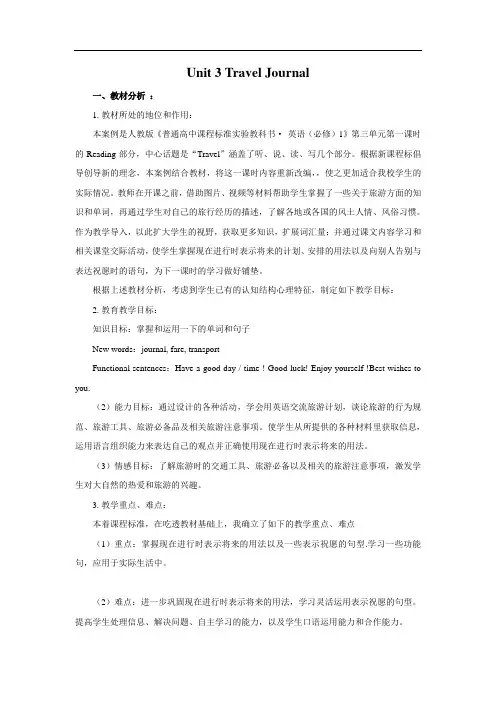
Unit 3Travel Journal一、教材分析:1. 教材所处的地位和作用:本案例是人教版《普通高中课程标准实验教科书·英语(必修)1》第三单元第一课时的Reading部分,中心话题是“Travel”涵盖了听、说、读、写几个部分。
根据新课程标倡导创导新的理念,本案例结合教材,将这一课时内容重新改编,,使之更加适合我校学生的实际情况。
教师在开课之前,借助图片、视频等材料帮助学生掌握了一些关于旅游方面的知识和单词,再通过学生对自己的旅行经历的描述,了解各地或各国的风土人情、风俗习惯。
作为教学导入,以此扩大学生的视野,获取更多知识,扩展词汇量;并通过课文内容学习和相关课堂交际活动,使学生掌握现在进行时表示将来的计划、安排的用法以及向别人告别与表达祝愿时的语句,为下一课时的学习做好铺垫。
根据上述教材分析,考虑到学生已有的认知结构心理特征,制定如下教学目标:2. 教育教学目标:知识目标:掌握和运用一下的单词和句子New words:journal, fare, transportFunctional sentences:Have a good day / time ! Good luck! Enjoy yourself !Best wishes to you.(2)能力目标:通过设计的各种活动,学会用英语交流旅游计划,谈论旅游的行为规范、旅游工具、旅游必备品及相关旅游注意事项。
使学生从所提供的各种材料里获取信息,运用语言组织能力来表达自己的观点并正确使用现在进行时表示将来的用法。
(3)情感目标:了解旅游时的交通工具、旅游必备以及相关的旅游注意事项,激发学生对大自然的热爱和旅游的兴趣。
3. 教学重点、难点:本着课程标准,在吃透教材基础上,我确立了如下的教学重点、难点(1)重点:掌握现在进行时表示将来的用法以及一些表示祝愿的句型.学习一些功能句,应用于实际生活中。
(2)难点:进一步巩固现在进行时表示将来的用法,学习灵活运用表示祝愿的句型。
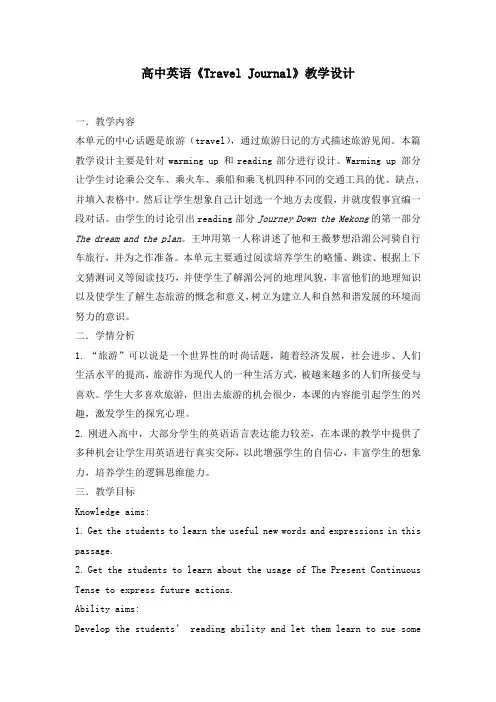
高中英语《Travel Journal》教学设计一.教学内容本单元的中心话题是旅游(travel),通过旅游日记的方式描述旅游见闻。
本篇教学设计主要是针对warming up 和reading部分进行设计。
Warming up 部分让学生讨论乘公交车、乘火车、乘船和乘飞机四种不同的交通工具的优、缺点,并填入表格中。
然后让学生想象自己计划选一个地方去度假,并就度假事宜编一段对话。
由学生的讨论引出reading部分Journey Down the Mekong的第一部分The dream and the plan。
王坤用第一人称讲述了他和王薇梦想沿湄公河骑自行车旅行,并为之作准备。
本单元主要通过阅读培养学生的略懂、跳读、根据上下文猜测词义等阅读技巧,并使学生了解湄公河的地理风貌,丰富他们的地理知识以及使学生了解生态旅游的慨念和意义,树立为建立人和自然和谐发展的环境而努力的意识。
二.学情分析1.“旅游”可以说是一个世界性的时尚话题,随着经济发展,社会进步、人们生活水平的提高,旅游作为现代人的一种生活方式,被越来越多的人们所接受与喜欢。
学生大多喜欢旅游,但出去旅游的机会很少,本课的内容能引起学生的兴趣,激发学生的探究心理。
2.刚进入高中,大部分学生的英语语言表达能力较差,在本课的教学中提供了多种机会让学生用英语进行真实交际,以此增强学生的自信心,丰富学生的想象力,培养学生的逻辑思维能力。
三.教学目标Knowledge aims:1.Get the students to learn the useful new words and expressions in this passage.2.Get the students to learn about the usage of The Present Continuous Tense to express future actions.Ability aims:Develop the students’ reading ability and let them learn to sue somereading strategies such as skimming,scanning, and so on.Emotional aim:Stimulate the students’ love for nature by getting them to know a great river.四.教学重点Get the students to master different reading skills.五.教学难点Develop the students’reading ability, especially the ability of understanding implied meanings.六.教学方法Task-based teaching and learning; cooperative learning and discussion. 七.教学设备The multimedia and other normal teaching tools.八.教学过程Step 1. warming --up and lead-- inTeacher: Good morning, boys and girls. Summer vocation is coming, do you have any plans? (Students will have many plans and want to share with us. we will have a free talk.) Thanks for your sharing .I would like to talk about one of my holiday plans-- go traveling. (Then I will use the multimedia to show some pictures, which I took in different cities of China, such as Beijing, Shanghai, Hangzhou and so on. I think that they can stimulate students interests in traveling.) If you are given a chance to travel around the world, what kind of transportations will you use and why?向学生展示不同城市的美丽风景,引起学生对旅游的兴趣。
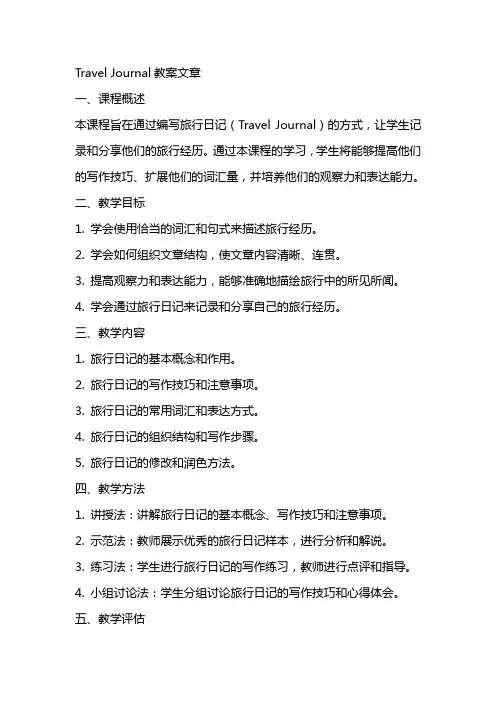
Travel Journal教案文章一、课程概述本课程旨在通过编写旅行日记(Travel Journal)的方式,让学生记录和分享他们的旅行经历。
通过本课程的学习,学生将能够提高他们的写作技巧、扩展他们的词汇量,并培养他们的观察力和表达能力。
二、教学目标1. 学会使用恰当的词汇和句式来描述旅行经历。
2. 学会如何组织文章结构,使文章内容清晰、连贯。
3. 提高观察力和表达能力,能够准确地描绘旅行中的所见所闻。
4. 学会通过旅行日记来记录和分享自己的旅行经历。
三、教学内容1. 旅行日记的基本概念和作用。
2. 旅行日记的写作技巧和注意事项。
3. 旅行日记的常用词汇和表达方式。
4. 旅行日记的组织结构和写作步骤。
5. 旅行日记的修改和润色方法。
四、教学方法1. 讲授法:讲解旅行日记的基本概念、写作技巧和注意事项。
2. 示范法:教师展示优秀的旅行日记样本,进行分析和解说。
3. 练习法:学生进行旅行日记的写作练习,教师进行点评和指导。
4. 小组讨论法:学生分组讨论旅行日记的写作技巧和心得体会。
五、教学评估1. 课堂参与度:学生参与课堂讨论和练习的积极程度。
2. 旅行日记写作:学生完成的旅行日记质量,包括内容、结构、词汇和语法等方面。
3. 自我评估:学生对自己旅行日记的修改和润色过程进行自我评估。
4. 同伴评估:学生之间互相评估对方的旅行日记,给出建议和意见。
六、教学准备1. 教材:旅行日记范文、旅行相关词汇和表达方式的资料。
2. 工具:投影仪、白板、教学PPT。
3. 材料:学生的旅行照片、旅行经历相关的问题和讨论话题。
七、教学计划第1周:介绍旅行日记的基本概念和作用。
第2周:讲解旅行日记的写作技巧和注意事项。
第3周:学习旅行日记的常用词汇和表达方式。
第4周:练习旅行日记的组织结构和写作步骤。
第5周:修改和润色旅行日记。
第6周:分享旅行日记,进行评价和反馈。
八、教学活动1. 第1周:教师介绍旅行日记的基本概念和作用,引导学生认识到旅行日记的重要性。
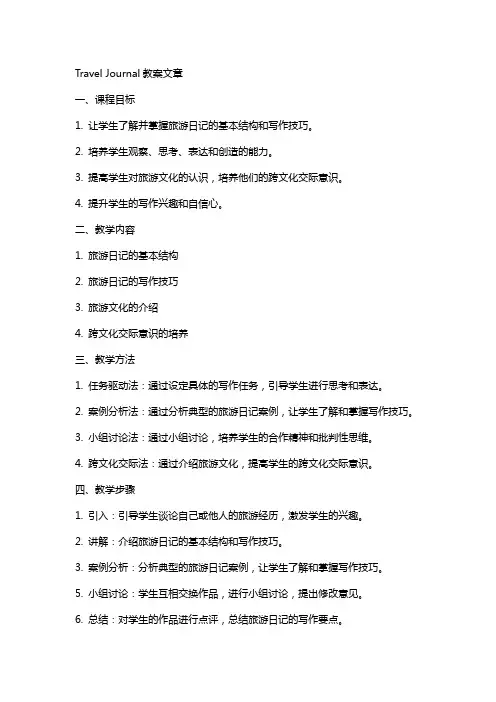
Travel Journal教案文章一、课程目标1. 让学生了解并掌握旅游日记的基本结构和写作技巧。
2. 培养学生观察、思考、表达和创造的能力。
3. 提高学生对旅游文化的认识,培养他们的跨文化交际意识。
4. 提升学生的写作兴趣和自信心。
二、教学内容1. 旅游日记的基本结构2. 旅游日记的写作技巧3. 旅游文化的介绍4. 跨文化交际意识的培养三、教学方法1. 任务驱动法:通过设定具体的写作任务,引导学生进行思考和表达。
2. 案例分析法:通过分析典型的旅游日记案例,让学生了解和掌握写作技巧。
3. 小组讨论法:通过小组讨论,培养学生的合作精神和批判性思维。
4. 跨文化交际法:通过介绍旅游文化,提高学生的跨文化交际意识。
四、教学步骤1. 引入:引导学生谈论自己或他人的旅游经历,激发学生的兴趣。
2. 讲解:介绍旅游日记的基本结构和写作技巧。
3. 案例分析:分析典型的旅游日记案例,让学生了解和掌握写作技巧。
5. 小组讨论:学生互相交换作品,进行小组讨论,提出修改意见。
6. 总结:对学生的作品进行点评,总结旅游日记的写作要点。
五、教学评价1. 学生旅游日记的完成情况。
2. 学生参与小组讨论的积极程度。
3. 学生对旅游文化的理解和跨文化交际能力的提升。
4. 学生对写作的自信心和兴趣的提高。
六、教学资源1. 旅游日记案例:收集一些典型的旅游日记案例,用于分析和讨论。
2. 旅游文化资料:提供一些关于不同地区和国家的旅游文化资料,用于学生了解和参考。
3. 写作指导资料:提供一些关于旅游日记写作的指导资料,如写作技巧、结构等。
4. 评价标准:制定旅游日记的评价标准,以便学生了解要求和进行自我评价。
七、教学环境1. 教室:提供足够的空间供学生进行讨论和写作。
2. 电脑和投影仪:用于展示案例和资料。
3. 白板或黑板:用于板书和展示评价标准。
八、教学拓展活动1. 组织一次旅游体验活动,让学生亲身体验旅游的乐趣和感受。
2. 举办一次旅游日记展览,让学生展示自己的作品,并互相学习和交流。
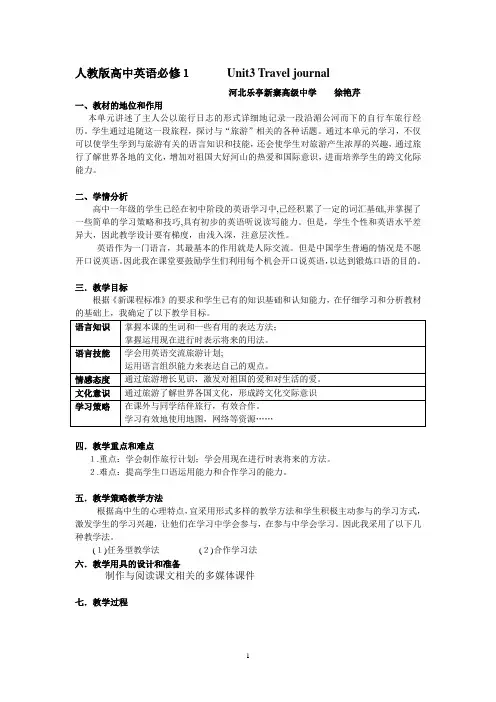
人教版高中英语必修1Unit3 Travel journal河北乐亭新寨高级中学徐艳芹一、教材的地位和作用本单元讲述了主人公以旅行日志的形式详细地记录一段沿湄公河而下的自行车旅行经历。
学生通过追随这一段旅程,探讨与“旅游”相关的各种话题。
通过本单元的学习,不仅可以使学生学到与旅游有关的语言知识和技能,还会使学生对旅游产生浓厚的兴趣,通过旅行了解世界各地的文化,增加对祖国大好河山的热爱和国际意识,进而培养学生的跨文化际能力。
二、学情分析高中一年级的学生已经在初中阶段的英语学习中,已经积累了一定的词汇基础,并掌握了一些简单的学习策略和技巧,具有初步的英语听说读写能力。
但是,学生个性和英语水平差异大,因此教学设计要有梯度,由浅入深,注意层次性。
英语作为一门语言,其最基本的作用就是人际交流。
但是中国学生普遍的情况是不愿开口说英语。
因此我在课堂要鼓励学生们利用每个机会开口说英语,以达到锻炼口语的目的。
三.教学目标根据《新课程标准》的要求和学生已有的知识基础和认知能力,在仔细学习和分析教材四.教学重点和难点1.重点:学会制作旅行计划;学会用现在进行时表将来的方法。
2.难点:提高学生口语运用能力和合作学习的能力。
五.教学策略教学方法根据高中生的心理特点,宜采用形式多样的教学方法和学生积极主动参与的学习方式,激发学生的学习兴趣,让他们在学习中学会参与,在参与中学会学习。
因此我采用了以下几种教学法。
(1)任务型教学法(2)合作学习法六.教学用具的设计和准备制作与阅读课文相关的多媒体课件七.教学过程Step1 Lead in 导入学习这节课时,学生们不久前正好从国庆节休假回来,可以充分利用这个机会,以两人对话或小组的形式来讲述每个人旅行经历,有条件的话可以和大家分享照片和视频,让他们也可以感受其中的乐趣并了解更多的旅游知识,从而引入本节课的主题:旅行计划以及旅行前的准备。
设计意图:旅游是学生比较感兴趣的话题,用这个和学生生活密切相关的话题和经历来引起学生的学习兴趣和热情。
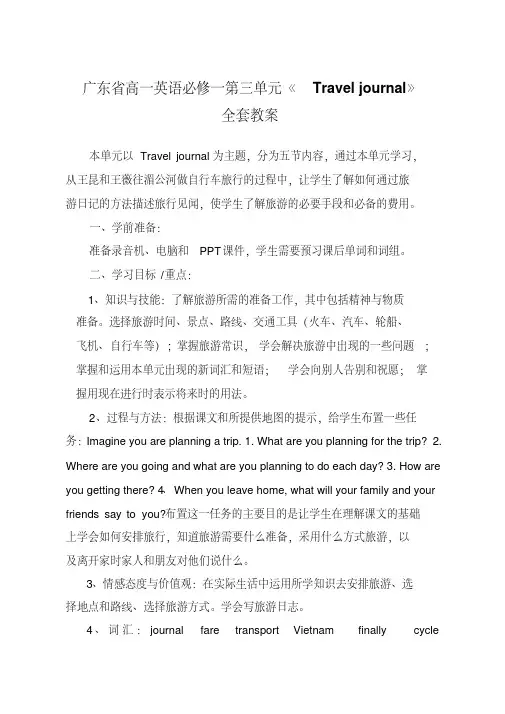
广东省高一英语必修一第三单元《Travel journal》全套教案本单元以Travel journal为主题,分为五节内容,通过本单元学习,从王昆和王薇往湄公河做自行车旅行的过程中,让学生了解如何通过旅游日记的方法描述旅行见闻,使学生了解旅游的必要手段和必备的费用。
一、学前准备:准备录音机、电脑和PPT课件,学生需要预习课后单词和词组。
二、学习目标/重点:1、知识与技能:了解旅游所需的准备工作,其中包括精神与物质准备。
选择旅游时间、景点、路线、交通工具(火车、汽车、轮船、飞机、自行车等); 掌握旅游常识,学会解决旅游中出现的一些问题; 掌握和运用本单元出现的新词汇和短语;学会向别人告别和祝愿;掌握用现在进行时表示将来时的用法。
2、过程与方法:根据课文和所提供地图的提示,给学生布置一些任务:Imagine you are planning a trip. 1. What are you planning for the trip? 2. Where are you going and what are you planning to do each day? 3. How are you getting there? 4、When you leave home, what will your family and your friends say to you?布置这一任务的主要目的是让学生在理解课文的基础上学会如何安排旅行,知道旅游需要什么准备,采用什么方式旅游,以及离开家时家人和朋友对他们说什么。
3、情感态度与价值观:在实际生活中运用所学知识去安排旅游、选择地点和路线、选择旅游方式。
学会写旅游日志。
4、词汇:journal fare transport Vietnam finally cyclepersuade stubborn insist proper properly determine determined altitude valley attitude shorts camp record topic familiar brave5、短语:change one’s mind give in6、重点语法项目:现在进行时表将来。
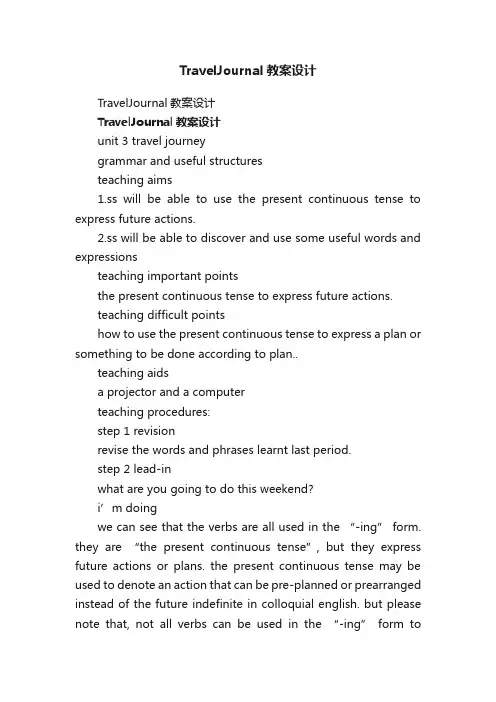
TravelJournal教案设计TravelJournal教案设计TravelJournal教案设计unit 3 travel journeygrammar and useful structuresteaching aims1.ss will be able to use the present continuous tense to express future actions.2.ss will be able to discover and use some useful words and expressionsteaching important pointsthe present continuous tense to express future actions.teaching difficult pointshow to use the present continuous tense to express a plan or something to be done according to plan..teaching aidsa projector and a computerteaching procedures:step 1 revisionrevise the words and phrases learnt last period.step 2 lead-inwhat are you going to do this weekend?i’m doingwe can see that the ver bs are all used in the “-ing” form. they are “the present continuous tense”, but they express future actions or plans. the present continuous tense may be used to denote an action that can be pre-planned or prearranged instead of the future indefinite in colloquial english. but please note that, not all verbs can be used in the “-ing” form toexpress future actions. such verbs as come, go, leave, fly, walk, ride, drive, stay, meet, die, see, have, arrive etc. are mainly used in the “-ing” form to express fu ture actions.step 3 practice1.look at the following dialogue and underline the verbs in this tense.a: are you working this evening?b: no. we’re having an english party, don’t you know?a: yes, i do. and we’re giving some performance at the party. what are you going to do?b: i’m singing song with my classmates.2. doing exercises no. 2 and 3 on page 21now turn to page 21 and do exercise 2. in the dialogue a newspaper reporter is interviewing wang wei about her plans for the trip along the mekong river. however, they are not sure about some of the verb tenses. can you help them complete their conversation?let’s continue to do exercise 3. do you have any plans for the future yourselves? if you have any, please use the present continuous tense to express your future actions. give as much information as you can.step4 dialogue1. first show an example: where you going on holiday?a: yanzi, where you going on holiday? b: i’ m going to laos.a: when are you leaving? b: next sunday.a: how are you going to lao s? b: i’m taking a plane.a: how long are you staying there? b: about two weeks.a: great. have a good trip. b: thanks.。
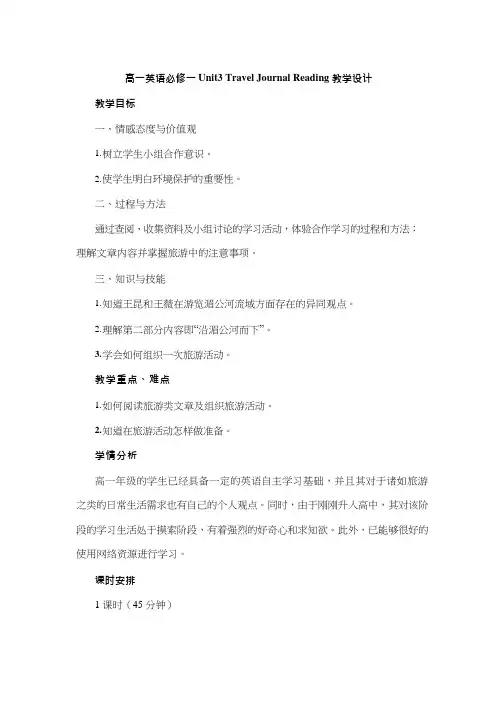
高一英语必修一Unit3 Travel Journal Reading 教学设计教学目标一、情感态度与价值观1.树立学生小组合作意识。
2.使学生明白环境保护的重要性。
二、过程与方法通过查阅、收集资料及小组讨论的学习活动,体验合作学习的过程和方法;理解文章内容并掌握旅游中的注意事项。
三、知识与技能1.知道王昆和王薇在游览湄公河流域方面存在的异同观点。
2.理解第二部分内容即“沿湄公河而下”。
3.学会如何组织一次旅游活动。
教学重点、难点1.如何阅读旅游类文章及组织旅游活动。
2.知道在旅游活动怎样做准备。
学情分析高一年级的学生已经具备一定的英语自主学习基础,并且其对于诸如旅游之类的日常生活需求也有自己的个人观点。
同时,由于刚刚升入高中,其对该阶段的学习生活处于摸索阶段,有着强烈的好奇心和求知欲。
此外,已能够很好的使用网络资源进行学习。
课时安排1 课时(45 分钟)授课方法讲授法、小组讨论与展示教学资源 多媒体课件 教学过程Step 1 Greeting Step 2 RevisionT :First ,I’ll ask some of you to give the answers to the exercises in Part 1 on Page 57.Suggested answers : are going/will go/am going to stay/will stay/am staying is going to fly/will fly/is f lyingis going to take/will take/is taking ;leaves is giving ;is saying am comingare ;going ;are ;getting bought ;will buy/are going to buy ;met ;will meet/are meeting/are going to meetStep 3 Lead inT : Here is good news.Your favorite singer Jay will give performances in Wuxi Stadium.But tomorrow you will take an English exam.What will you do ? S 1:Forget the exam and enjoy the concert first.S 2 : Forget the concert.Get well prepared for the exam.I can enjoy another concert of his some day.S 3:... S 4:...T : So we can see different students have different ideas , or different students hold different attitudes. ( Write “hold a...attitude” on the blackboard ).Do you know what an attitude is ?S :An attitude is what a person thinks about something.T :Yes ,usually different people hold different attitudes.Let’s turn back to Part One of this unit and make a comparison between Wang Kung’s and Wang Wei’s attitudes toward the trip along the Mekong.Present the chart on the screen ;then give Ss a few minutes to discuss.difference设计意图:以练习的形式通过复习上节课内容,加深学生对重点句型的理解和应用。
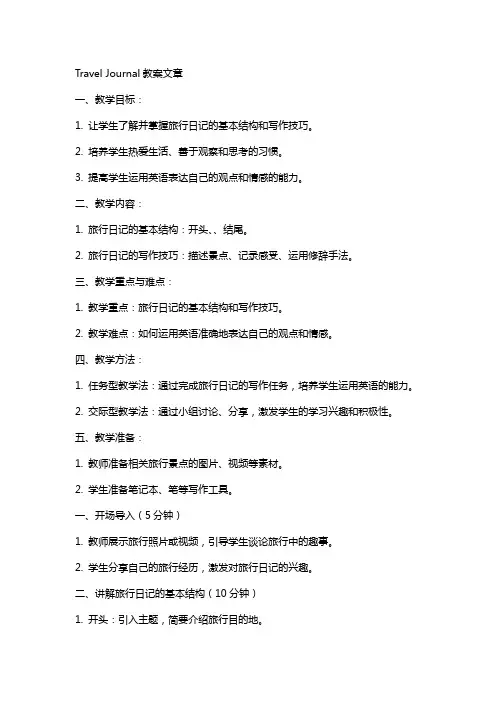
Travel Journal教案文章一、教学目标:1. 让学生了解并掌握旅行日记的基本结构和写作技巧。
2. 培养学生热爱生活、善于观察和思考的习惯。
3. 提高学生运用英语表达自己的观点和情感的能力。
二、教学内容:1. 旅行日记的基本结构:开头、、结尾。
2. 旅行日记的写作技巧:描述景点、记录感受、运用修辞手法。
三、教学重点与难点:1. 教学重点:旅行日记的基本结构和写作技巧。
2. 教学难点:如何运用英语准确地表达自己的观点和情感。
四、教学方法:1. 任务型教学法:通过完成旅行日记的写作任务,培养学生运用英语的能力。
2. 交际型教学法:通过小组讨论、分享,激发学生的学习兴趣和积极性。
五、教学准备:1. 教师准备相关旅行景点的图片、视频等素材。
2. 学生准备笔记本、笔等写作工具。
一、开场导入(5分钟)1. 教师展示旅行照片或视频,引导学生谈论旅行中的趣事。
2. 学生分享自己的旅行经历,激发对旅行日记的兴趣。
二、讲解旅行日记的基本结构(10分钟)1. 开头:引入主题,简要介绍旅行目的地。
2. 详细描述景点、活动、感受等。
三、讲解旅行日记的写作技巧(10分钟)1. 描述景点:运用形象生动的语言,描绘景物特点。
2. 记录感受:真实地记录旅行中的喜怒哀乐。
3. 运用修辞手法:如比喻、拟人等,增强文章表现力。
四、小组讨论(15分钟)1. 学生分组,讨论旅行日记的写作技巧。
2. 每组选取一个景点,练习运用所学技巧进行描述。
五、课堂练习(15分钟)1. 学生根据所学内容,编写一篇旅行日记。
2. 教师巡回指导,解答学生疑问。
六、分享与评价(10分钟)1. 学生互相分享旅行日记,交流写作心得。
2. 教师对学生的作品进行点评,给予鼓励和建议。
七、课后作业(课后自主完成)1. 修改和完善旅行日记,准备参加下一节课的展示。
2. 收集更多关于旅行的话题,为后续写作做好准备。
八、教学反思(教师课后完成)2. 针对学生的掌握情况,调整后续教学内容和方法。
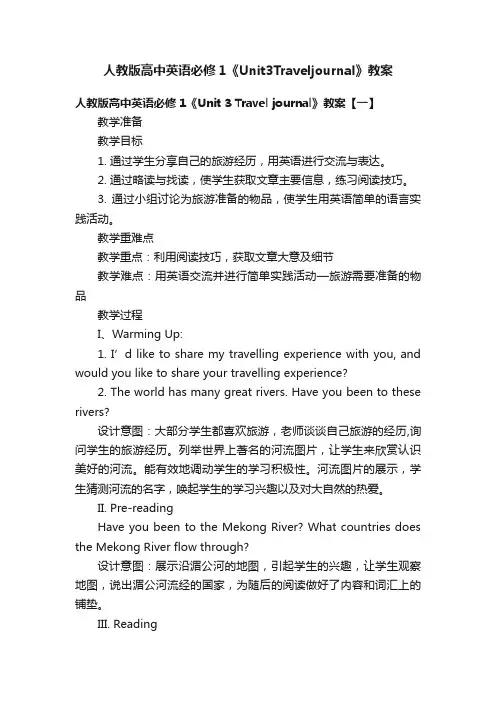
人教版高中英语必修1《Unit3Traveljournal》教案人教版高中英语必修1《Unit 3 Travel journal》教案【一】教学准备教学目标1. 通过学生分享自己的旅游经历,用英语进行交流与表达。
2. 通过略读与找读,使学生获取文章主要信息,练习阅读技巧。
3. 通过小组讨论为旅游准备的物品,使学生用英语简单的语言实践活动。
教学重难点教学重点:利用阅读技巧,获取文章大意及细节教学难点:用英语交流并进行简单实践活动—旅游需要准备的物品教学过程I、Warming Up:1. I’d like to share my travelling experience with you, and would you like to share your travelling experience?2. The world has many great rivers. Have you been to these rivers?设计意图:大部分学生都喜欢旅游,老师谈谈自己旅游的经历,询问学生的旅游经历。
列举世界上著名的河流图片,让学生来欣赏认识美好的河流。
能有效地调动学生的学习积极性。
河流图片的展示,学生猜测河流的名字,唤起学生的学习兴趣以及对大自然的热爱。
II. Pre-readingHave you been to the Mekong River? What countries does the Mekong River flow through?设计意图:展示沿湄公河的地图,引起学生的兴趣,让学生观察地图,说出湄公河流经的国家,为随后的阅读做好了内容和词汇上的铺垫。
III. Reading1. SkimmingSkim the passage and find the main idea for each paragraph Para 1: DreamPara 2: A stubborn sisterPara 3: Preparation设计意图:略读:学生快速浏览课文,寻找相关信息并搭配段落大意。
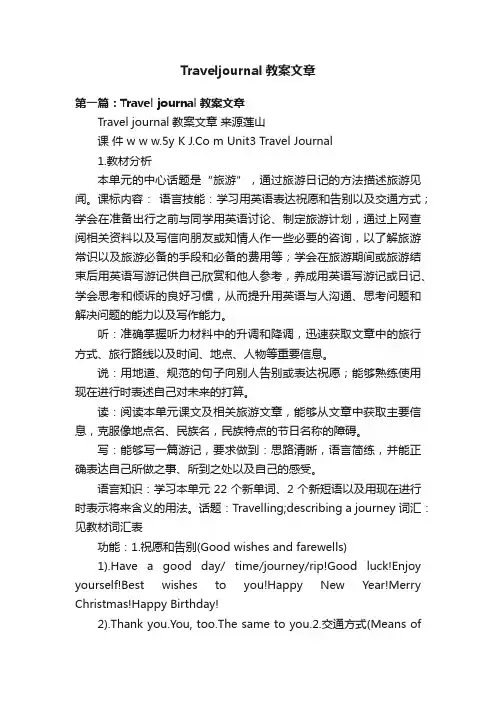
Traveljournal教案文章第一篇:Travel journal教案文章Travel journal教案文章来源莲山课件 w w w.5y K J.Co m Unit3 Travel Journal1.教材分析本单元的中心话题是“旅游”,通过旅游日记的方法描述旅游见闻。
课标内容:语言技能:学习用英语表达祝愿和告别以及交通方式;学会在准备出行之前与同学用英语讨论、制定旅游计划,通过上网查阅相关资料以及写信向朋友或知情人作一些必要的咨询,以了解旅游常识以及旅游必备的手段和必备的费用等;学会在旅游期间或旅游结束后用英语写游记供自己欣赏和他人参考,养成用英语写游记或日记、学会思考和倾诉的良好习惯,从而提升用英语与人沟通、思考问题和解决问题的能力以及写作能力。
听:准确掌握听力材料中的升调和降调,迅速获取文章中的旅行方式、旅行路线以及时间、地点、人物等重要信息。
说:用地道、规范的句子向别人告别或表达祝愿;能够熟练使用现在进行时表述自己对未来的打算。
读:阅读本单元课文及相关旅游文章,能够从文章中获取主要信息,克服像地点名、民族名,民族特点的节日名称的障碍。
写:能够写一篇游记,要求做到:思路清晰,语言简练,并能正确表达自己所做之事、所到之处以及自己的感受。
语言知识:学习本单元22个新单词、2个新短语以及用现在进行时表示将来含义的用法。
话题:Travelling;describing a journey 词汇:见教材词汇表功能:1.祝愿和告别(Good wishes and farewells)1).Have a good day/ time/journey/rip!Good luck!Enjoy yourself!Best wishes to you!Happy New Year!Merry Christmas!Happy Birthday!2).Thank you.You, too.The same to you.2.交通方式(Means oftransportation)walking, cycling, horse riding, taking buses/trains/boats/plane 语法:现在进行时表示将来When are you leaving?How are you going there?Where are you staying?How long are you staying there?When are you coming back? 情感态度和价值观:通过课文的学习,要求同学们能够积极参与关于旅行准备、旅游见闻、旅游感受等方面的交流活动,用准确的英语描述国内外的重要景观、名胜古迹以及一些当地的旅游文化节日。
Travel Journal 高中英语教案一、教学目标1. 让学生通过编写旅行日志,提高英语写作能力。
2. 培养学生运用英语描述旅行经历、表达感受和观点的能力。
3. 增强学生的跨文化交际意识,提高与人分享旅行见闻的积极性。
二、教学内容1. 旅行日志的格式与要素。
2. 旅行经历的描述与表达。
3. 旅行感悟的分享与交流。
三、教学方法1. 任务驱动法:通过设定旅行日志的写作任务,引导学生积极参与。
2. 交际法:鼓励学生运用英语进行旅行经历的描述与分享。
3. 小组合作学习法:学生分组合作,互相评改、交流旅行日志。
四、教学步骤1. 引入:教师展示自己的旅行日志,激发学生的兴趣。
2. 讲解:介绍旅行日志的格式与要素,如日期、地点、人物、经历、感悟等。
3. 示范:教师示范编写一篇旅行日志,讲解写作技巧。
4. 练习:学生分组进行旅行日志的编写,可以选择自己真实的旅行经历。
5. 展示与评价:学生分组展示旅行日志,互相评价,教师给予点评和指导。
五、作业布置1. 完成一篇旅行日志,要求包括日期、地点、人物、经历、感悟等要素。
2. 收集同学间的旅行日志,进行互相评改,提出改进意见。
3. 准备下一节课的分享,选定一个旅行目的地,查阅相关资料,制作PPT。
六、教学目标1. 扩展学生的词汇量和句型结构,以便更准确地表达旅行经历。
2. 培养学生运用过去时态描述旅行中的事件。
3. 提高学生的批判性思维能力,学会从不同角度评价旅行日志。
七、教学内容1. 旅行日志中常用的词汇和表达。
2. 过去时态在旅行日志中的应用。
3. 批判性思维的培养与运用。
八、教学方法1. 情景教学法:通过设定旅行场景,让学生实践运用过去时态描述旅行经历。
2. 讨论法:引导学生就旅行日志的内容和形式进行小组讨论,提出改进意见。
3. 反馈法:教师针对学生的旅行日志提供具体、细致的反馈,帮助学生提高。
九、教学步骤1. 复习:回顾上一节课的旅行日志编写内容,引导学生关注过去时态的使用。
《Unit3Travel journal》教学设计
一、教学目标
1.掌握与旅行相关的词汇和表达。
2.能够描述自己的旅行经历或计划。
3.培养学生对旅行的热爱和探索精神。
二、教学重难点
1.重点:词汇和表达的掌握,旅行描述。
2.难点:用英语连贯地描述旅行经历。
三、教学方法
情景模拟法、口语表达法、写作训练法。
四、教学过程
1.导入
展示一些美丽的旅游景点图片,激发学生对旅行的兴趣。
2.词汇学习
(1)教授与旅行相关的词汇,如journey、destination、adventure等。
(2)通过词汇接龙游戏巩固词汇。
3.口语练习
(1)学生两人一组,互相询问对方的旅行经历。
(2)分享有趣的旅行故事。
4.写作训练
(1)让学生写一篇自己的旅行日记或旅行计划。
(2)展示优秀作品,进行点评。
5.课堂小结
总结旅行相关的词汇和表达,以及如何描述旅行。
6.作业布置
(1)制作一份自己梦想旅行地的海报,用英语介绍。
(2)阅读一篇关于旅行的英语文章。
Travel;journal教案the sixth period●沉着说课this is the sixth period of the unit.as usual,the teacher will do some revision.for part 2 on page 57,the teacher can ask individual student to come to the blackboard and write one sentence each.then ask several other ss to correct the mistakes,if there are any,and ask them to give reasons.through these activities,ss are given not only translation exercises,but also proofreading exercises,in which the mistakes are the typical ones made by ss themselves.by checking the exercise,the teacher can find out what ss are still not quite familiar with and needs to be improved and make some necessary change of his/her teaching plans.in this period still ss will be given some listening tasks—part 4 of journal down the mekong and part 5 on page 58.ss will also do some extensive reading,which will help them get a general idea about the three countries in the mekong delta—laos,cambodia and vietnam. after that,the teacher will talk about a few phrasesand an important structure in this passage.●三维目标1.knowledge:〔1〕learn to translate sentences with reference words and structures.〔2〕understand the listening and reading passages. 2.ability:grasp basic listening and reading skills.3.emotion:get ss to know about the three countries in the mekong delta region,thus stimulate ss’ love for nature.●教学重点〔1〕listen and understand the key words and understand the speakers’ intention and attitude.〔2〕read and get to know about the three countries in the mekong delta region.●教学难点expressing ways of multiple.●教具打算multi-media classroom and other normal teaching tools.●教学过程step 1 greetingsstep 2 revisiont:first i’ll ask ten students to come to the blackboard and write one sentence each.who will be the volunteers?ten students come to the blackboard and write down the ten sentences.t:we will see if these sentences are ok.let’s talk about them sentence by sentence.if there are any mistakes,please stand up and point them out and tell us why.step 3 listeningt:now please look at part 4 on page 55.we will do some listening.〔1〕first listeningt:before we start,you’d better go through these words to see if you can pronounce them very well.our first task is to tick the words you hear on the tape.t:now,who will read the words you hear?s1:...t:what are your words,tom?s2:...t:here are the words i hear:...〔2〕second listeningt:this time.you’d write down the answers to the five questions.boys and girls,how can we write the answers fast and correctly?s:we should go through the questions first and keep them in mind.when we are listening,we just need to pay attention to the sentences related to the answers. s:we needn’t write down each word of the answers.we just write down some key ter we can write down the complete answers with the help of these key words.t:you are clever.now please get ready.two minutes later,the teacher plays the tape.then give ss time to organize their sentences.〔3〕check the answersstep 4 listening1.first listeningt:now they arrived at laos.please listen to the tape and pick out the correct answers in exercise 1 on page 58.2.second listeningt:please look at the chart.while listening to the tapefor the second time,try to catch the related information to fill in the chart.topiclaosthe rivermethod of land transportlife in the villagesfood3.third listeningt:listen to the tape for the third time and find out the differences and similarities between china and laos in weather,animals,plants,and land.〔圆穿插局部呈现一样点,其余局部写不同点,如下列图所示〕step 5 readingt:this passage is the end of their journey.it talks about another two countries in the mekong delta region.by the way,if you want to tell others about a country,what will you most probably talk about?〔brainstorm the topics〕t:please read the passage,quickly tick the topicsmentioned.s:...s:...s:...t:population,economy〔poor〕,capital,farming,weather,building,animal.t:please go through the passage and find information to fill in the form.topiclaoscambodiavietnampopulationweatherlearningfarmingt:what impression do the countries give us?s:...s:...step 6 language pointst:words and structures in the workbook are also very important.now look at page 59,paragraph 2,can you find the phrase “ be tired from”?“be tired from” means “become tired because of” while “be tired of” means “be uninterested in”.look atthe two sentences:〔1〕after he got home,he fell down onto the sofa,for he was tired ____________ a day’s hard work.〔2〕he was tired ____________ disco music,for it was noisy.who can complete the sentences?s:i think we use “from” in sentence 1 and use “of” in sentence 2.t:you are right.now another important sentence in paragraph one “it has twice the population”.now i’ll teach you how to express the multiple of something. we have three different ways.〔1〕a is...times as ... as b.〔2〕a is...times + comparative degree than b.〔3〕a is ...times the+n. of b.let’s take “这个房间是那个房间的三倍”for example.what can we say?s1:we can say “this room is three times as big as that one.”s2:we can also say “this room is three times bigger than that one.”t:do you agree with him,class?s:...t:tell us the reason.s:we should say “this room is twice bigger than that one.”t:that’s right.who will say the sentence in anot her way?s:this room is three times the size of that one.t:good.now,how can we say “我们市人口比他们多五倍”?s:the population of our city is five times as large as theirs.s:our city has five times the population of theirs.s:the population of our city is four times larger than theirs.t:then look at the last sentence on page 59.pay attention to:one’s dream has come true.幻想成真。
traveljournal阅读教学设计Travel Journal 阅读教学设计导言:本次教学设计旨在培养学生阅读能力,并引导他们在旅行日志中发现故事背后的文化差异与体验。
通过结合实际情境,学生将学会阅读和理解旅行日志,并从中获取信息和思维技巧。
一、教学目标1. 学生能够通过阅读旅行日志,了解其中描述的国家、城市和景点;2. 学生能够理解旅行者在不同文化环境下的体验和感受;3. 学生能够通过旅行日志了解不同国家或地区的文化差异;4. 学生能够从旅行日志中获取信息,并进行思考和讨论。
二、教学准备1. 为学生准备一些旅行日志,涵盖不同国家或地区,风格各异;2. 准备一份辅助阅读材料,包括词汇表、文化背景知识等;3. 提供一些问题或任务,引导学生进行思考。
三、教学过程1. 引入:和学生一起回顾最近的旅行经历,让学生谈论旅行的好处以及能从旅行中学到什么,激发学生对旅行主题的兴趣。
2. 阅读:给每个学生分发一份旅行日志,并让他们仔细阅读。
鼓励学生在阅读过程中标记重要信息和生词。
3. 讨论:安排学生分组,让他们与小组成员分享他们阅读日志的体验。
引导他们讨论日志中描述的地点、文化和景点,并对他们的观点进行评价。
4. 文化背景:提供相关的文化背景知识,帮助学生更好地理解旅行日志中的文化差异。
可以通过图片、视频等多媒体资源进行展示。
5. 语言技巧:引导学生分析旅行日志中的语言技巧,例如比喻、对比、描写等,帮助他们进一步理解文本,并将这些技巧应用于自己的写作中。
6. 任务:给学生一些任务,例如写一篇类似的旅行日志,或者就特定问题进行讨论和写作。
通过任务的完成,评估学生对旅行日志的理解和应用能力。
7. 总结:和学生共同总结本次阅读教学的收获和体会。
鼓励他们提出问题和建议,以便改进今后的教学设计。
四、教学扩展1. 让学生自己撰写旅行日志,并和同学一起分享;2. 组织一次模拟旅行活动,让学生亲身体验旅行日志中描述的场景和文化差异;3. 鼓励学生使用多媒体技术,例如制作短视频或幻灯片展示自己的旅行日志。
Unit 3 Travel Journal教材分析本单元的话题是旅游,学生对此话题较为熟悉,应该有较浓厚的兴趣。
整个单元讲述的是主人公“王坤”以旅行日记的形式详细地记录自己沿着湄公河而下的自行车旅行。
学生通过追随作者的旅行,学习及探讨与旅游相关话题和内容,如:了解旅游常识,如何设计旅行计划,如何为旅行做准备,旅行的意义等。
通过本单元的学习,学生不仅能掌握与旅游及地理相关的主题词汇,理解和运用现在进行时表示将来的语法项目,还会通过探讨旅游话题了解世界各地的文化,增强对祖国河山的热爱和国际意识,进而开拓学生思路,培养学生的跨文化交际能力。
Warming up 部分先让学生分享国庆假期的游玩经历,引导学生探讨节假日旅行的利与弊。
通过对比分析几种常见交通方式的利弊,择优选择自己旅行的最佳出行方式,并尝试为自己设计旅行计划。
Reading部分先通过Pre-reading的问题,引导学生关注世界各大河流及人类对河流的利用,和理解湄公河在东南亚的地位及对东南亚各国人民的重要作用。
课文主要介绍了主人公王坤和王薇的梦想及骑自行车沿着湄公河旅行的计划和准备。
在整体理解课文主要内容后重点引导学生分析王坤和王薇两位主人公的性格及对旅行的不同态度。
Learning about Language以文本核心单词与词组为直接学习内容,加强学生的英英释意习惯,让学生学会利用字典及参考书进行自主归纳与学习。
在本课时的词汇学习中强调在语境中正确理解和运用词汇;Using Language集听、说、读、写于一体。
先通过读旅行日记的第二部分来了解其文体特征及内容、听一段关于王坤与老挝女孩的一段对话、探讨自己对老挝感兴趣的话题,写一封email询问王坤的旅行情况;Grammar是学习现在进行时表示将来的用法,并进行操练。
引导学生通过观察对比例句,总结归纳现在进行时表将来的用法及规律,并在生活情境中正确运用该语法项目。
在本单元的Learning Tip中给学生提出写旅行日志的方法和好处,鼓励学生外出旅行时写旅游日志(travel journal).教学目标(1)学习理解旅行日记Journey down the Mekong的行程及主人公的所见所闻;(2)能够熟练掌握并运用现在进行时表示将来的语法项目;(3)帮助学生掌握正确的旅游常识,及培养学生的安全意识及保护自然的责任感。
t r a v e l-j o u r n a l教
案
-CAL-FENGHAI-(2020YEAR-YICAI)_JINGBIAN
教案设计
Ability aims:
Develop the students’ reading ability and learn to use some reading strategies such as skimming ,scanning,and so on .
Emotional aims:
1. .stimulat the students’ love for nature by getting them to know the greatness of a river.
2. Develop the students’ sense of cooperation.
四.教学过程
Step 1:Lead in
【图片】Brainstorming some questions:
Do you like traveling
why do you like traveling
Where have you ever been before?
Show the chart and ask students to discuss it in pairs.
设计意图:利用图片导入,能激发学生的学习兴趣和背景知识,而且也激发学生的阅读动机。
Step2 pre-reading
【师生互动】
Do you any famous rivers in the world?
Can you guess what the names of these rivers are
Nile Amazon
Yangtze River Yellow River
According to these pictures, if you could follow the route of only one of them, which one would you choose?
设计意图:展示几张河流图片让学生猜测,选择两个学生回答问题“what river is it
”学生对中国的河流比较熟悉,能快速调动课堂气氛,并为引入课文创造创造时机。
Step 3 Reading
Task1. Skimming
The students read the passage quickly and answer the question:
(1).What are Wang Kun and Wang Wei going to do
(2)
(3)
(2).What are the main idea of the passage.
设计意图:梳理清楚课文线索,为各个环节的理解和开展做铺垫。
整体粗读,领略内容大意。
Task2. Scanning
Go through Comprehending Exercise 1 and make sure the students know what to do. Let them read the whole passage again to locate particular information and answer each question on Page 19.
Step 4 Reading for comprehending
【学生活动】
Task 1 True or false
1.Dao Wei and Yu Huang belong to the Han nationality.。